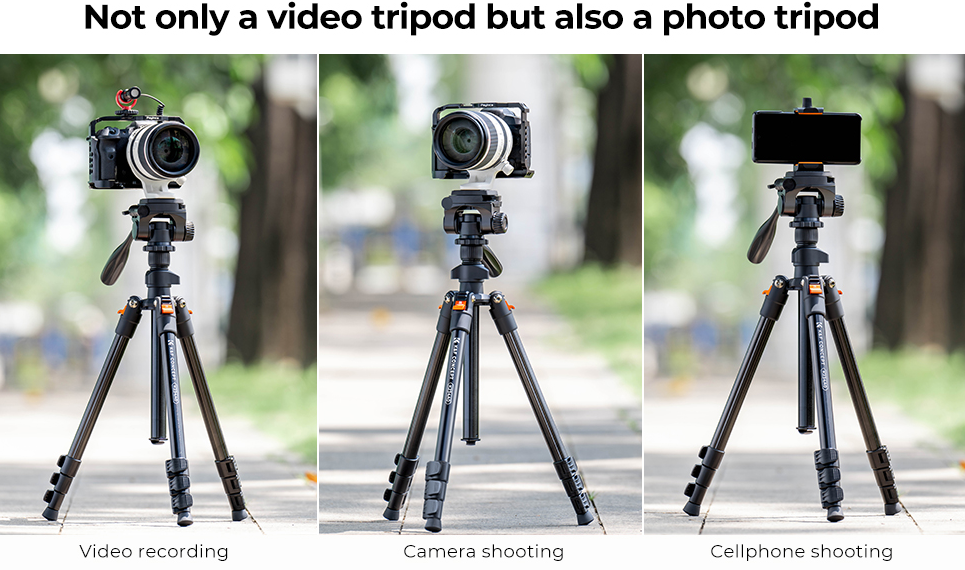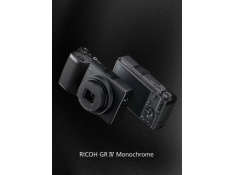Can you use a video tripod for photography?
Thursday 19 September 2024
 2.7k
2.7k
 Reproduction without the author's authorization is prohibited
Reproduction without the author's authorization is prohibited
Yes, you can certainly use a video tripod for photography. While video tripods are primarily designed for videography, they offer several advantages that make them suitable for still photography as well. These tripods are known for their stability, durability, and smooth fluid head systems, which are ideal for capturing both moving footage and static shots.
Video tripods are generally larger and heavier compared to standard camera tripods. This extra weight provides added stability, especially for longer exposure shots, where even a slight movement could lead to image blur. However, their size and bulk may not be the best option for photographers who prioritize portability and lightweight gear, particularly for travel photography.
Let's break down the components and examine whether a video tripod is a good option for your photography needs.
What Is a Video Tripod?
A video tripod is designed primarily to support video cameras during filming, ensuring smooth and controlled camera movements. Unlike photography tripods, which are primarily designed to hold a camera steady, video tripods are engineered with more robust legs and fluid heads that allow for panning and tilting, which is essential for videographers. This ability to smoothly follow a subject or scene makes video tripods perfect for dynamic shooting environments.
Video tripods also have a leveling base, which makes it easier to adjust the camera without altering the legs' height. This feature is especially useful in situations where quick changes in position are required.

What Is the Difference Between a Video Tripod and a Camera Tripod?
Weight and Build
One of the most noticeable differences between a video tripod and a camera tripod is weight. Video tripods tend to be heavier, as they are designed to support not only the weight of the camera but also additional accessories like external monitors, microphones, or video lights. The sturdy build helps to maintain stability, especially when panning or tilting during video shoots.Tripod Head
The tripod head is perhaps the most critical difference. Video tripods are equipped with a fluid head, which enables smooth motion in multiple directions. This is crucial for videography, where maintaining consistent, smooth movements is important. On the other hand, standard camera tripods typically come with ball heads or three-way pan heads, offering quick and precise positioning for still shots but without the same degree of smoothness in motion.Leg Design
Video tripods often have dual-stage legs, providing more stability over larger spans, while photography tripods may have fewer leg sections for faster setup. Additionally, some video tripods come with a spreader—an extra component that helps stabilize the legs, ensuring no shift occurs during filming.Portability
Photography tripods are generally more compact and lightweight, catering to photographers who need to travel light or move quickly between locations. While video tripods can be carried around, their heavier weight can be a burden for photographers on the go.Can You Use a Video Tripod for Photography?
Yes, you can use a video tripod for photography, and it can even offer some advantages over standard camera tripods in certain situations. Video tripods generally have more leg sections, which means they can extend higher and provide greater stability, especially when working with heavy camera setups or in windy conditions. The additional leg sections also allow for more fine-tuned height adjustments, but they can make the tripod bulkier to carry. Some video tripods may include a center column for vertical adjustments, although this feature is less common compared to photography tripods, where a center column is standard for quick height changes.
The head type is another critical factor that differentiates video tripods from photography tripods. Most video tripods are equipped with a fluid head, designed for smooth panning and tilting—perfect for video but also useful in certain photographic scenarios like panoramas or tracking moving subjects. However, the fluid head is typically larger and heavier than a ball head or three-way pan head, making it slower to reposition for still shots. While it may not be as convenient for fast, precise adjustments, the fluid head’s smooth operation can be beneficial for specialized photography that requires subtle, controlled movements.
What Video Tripod Is a Good Video Tripod?
When selecting a video tripod, it's essential to look for durability, ease of movement, and adaptability to your specific needs. Here are some features that make a video tripod stand out:
Fluid Head: The fluid head is the heart of a good video tripod. It should offer smooth panning and tilting, allowing you to capture dynamic footage without jerks or stutters. A well-designed fluid head is crucial for maintaining quality in motion, particularly if you plan to switch between video and photography.
Sturdy Legs: A good video tripod should have solid, well-built legs, preferably with dual-stage sections for added stability. Some high-end models offer carbon fiber legs, which reduce weight while maintaining strength.
Spreaders: Spreaders (mid-level or ground-level) improve the stability of the tripod by keeping the legs locked in place. This ensures the tripod doesn’t shift, even during intense panning.
Leveling Base: A leveling base allows you to adjust the head independently of the legs, which is helpful for uneven terrain. This feature makes it easier to quickly level the camera without adjusting each leg individually.
A good video tripod can enhance both your video and photography experience, especially if you're working in a studio or shooting landscapes where mobility isn’t a concern. However, photographers who are always on the move might prefer something more lightweight and compact, despite sacrificing some of the stability and fluid motion advantages.

Conclusion
It should be noted that among the many tripods of K&F CONCEPT, many can be used as both video and photography tripods. They can be easily adapted to various mobile phones/cameras by simply replacing the Quick Release Plate. One tripod can meet the needs of both photography and video shooting.
Statement: all contents and remarks made by K&F CONCEPT 's intranet friends only represent themselves and do not reflect any K&F CONCEPT 's opinions and views.
-
 How to Shoot Vintage Halloween PhotosTuesday 28 October 2025
How to Shoot Vintage Halloween PhotosTuesday 28 October 2025 -
 Ricoh announced 2 new models October 21stMonday 27 October 2025
Ricoh announced 2 new models October 21stMonday 27 October 2025 -
 Canon EOS R7 Mark II Camera to be Released in 2026Friday 24 October 2025
Canon EOS R7 Mark II Camera to be Released in 2026Friday 24 October 2025 -
 Sony is about to release the A1M2a camera, featuring a minor screen upgradeThursday 23 October 2025
Sony is about to release the A1M2a camera, featuring a minor screen upgradeThursday 23 October 2025 -
 Canon RF 45mm F1.2 STM full-frame lens is about to be releasedWednesday 22 October 2025
Canon RF 45mm F1.2 STM full-frame lens is about to be releasedWednesday 22 October 2025


